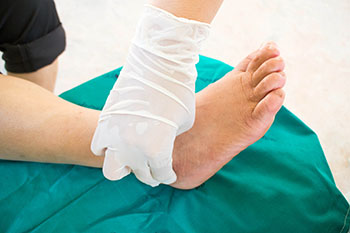
Ulcers, which are open sores in the skin, occur when the outer layers of the skin are injured and the deeper tissues become exposed. They can be caused by excess pressure due to ill-fitting shoes, long periods in bed, or after an injury that breaks the skin. Ulcers are commonly seen in patients who have diabetes, neuropathy or vascular disease. Open wounds can put patients at increased risk of developing infection in the skin and bone.
The signs and symptoms of ulcers may include drainage, odor, or red, inflamed, thickened tissue. Pain may or may not be present. Diagnosis may include x-rays to evaluate possible bone involvement. Other advanced imaging studies may also be ordered to evaluate for vascular disease, which may affect a patient’s ability to heal the wound.
Ulcers are treated by removing the unhealthy tissue and performing local wound care to assist in healing. Special shoes or padding may be used to remove excess pressure on the area. If infection is present, antibiotics will be necessary. In severe cases that involve extensive infection or are slow to heal, surgery or other advanced wound care treatments may be necessary.
Foot Health Facts for Diabetics
Having diabetes increases the risk of developing a wide range of foot problems, often because of two complications of the disease: nerve damage (neuropathy) and poor circulation.
For those with diabetes, small foot problems can turn into serious complications, including:
- ulcers (sores) that don’t heal
- corns
- calluses
- cracked heels
- hammertoes
- bunions
- ingrown nails
Untreated diabetes can result in other conditions, such as:
Diabetic peripheral neuropathy – this condition doesn’t emerge overnight. Instead, it usually develops slowly and worsens over time. Some patients have this condition long before they are diagnosed with diabetes. Having diabetes for several years may increase the likelihood of having diabetic neuropathy.
Charcot foot – a condition in which the bones of the foot are weakened enough to fracture. With continued walking the foot eventually changes shape. As the disorder progresses, the joints collapse and the foot takes on an abnormal shape, such as a rocker-bottom appearance.
To prevent complications of diabetes, patients are advised to follow diabetic foot care guidelines. Sometimes special diabetic shoes are prescribed to avoid pressure and rubbing on the feet caused by regular footwear.
